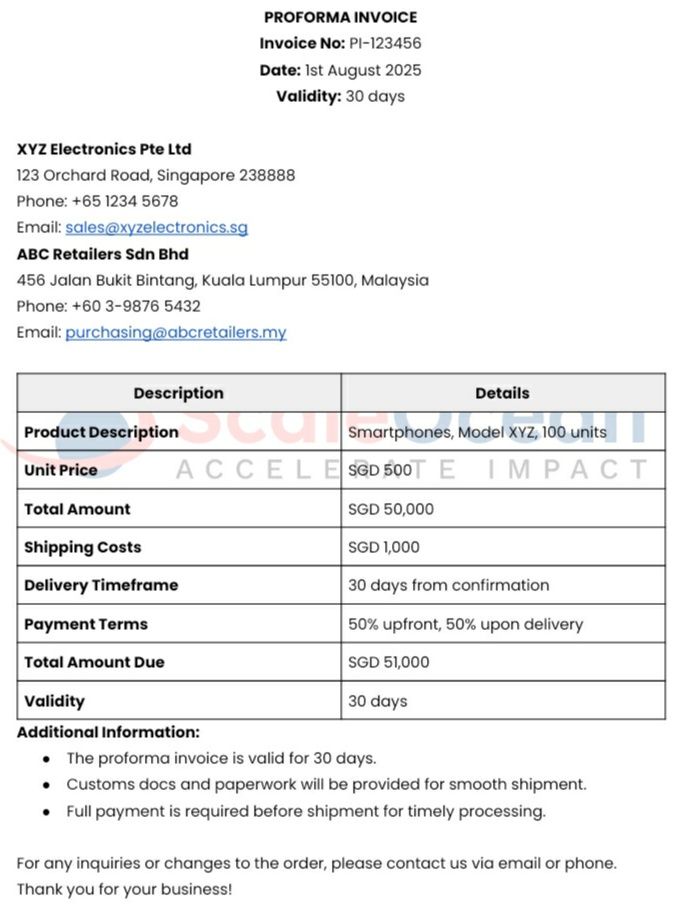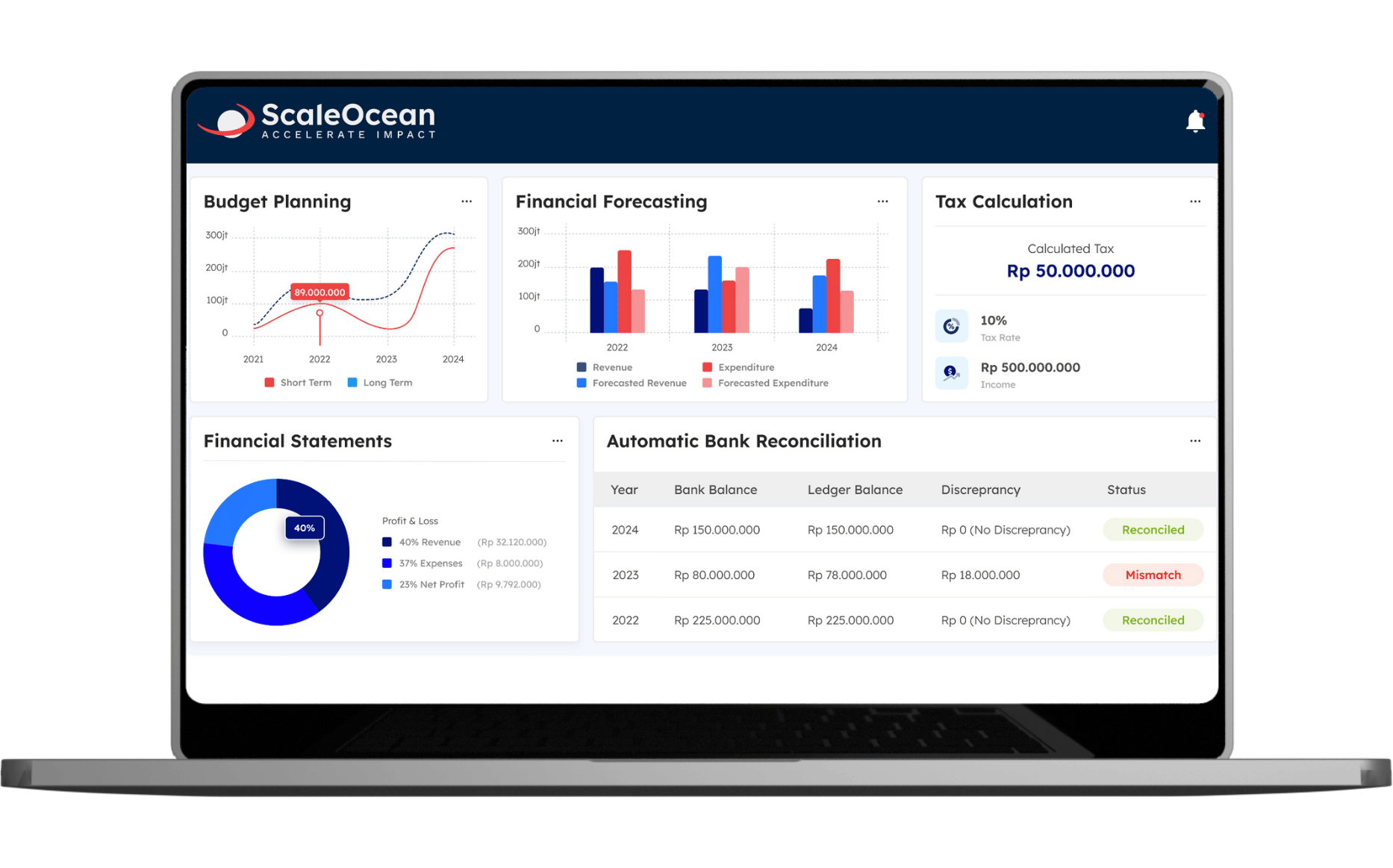In today’s competitive business landscape, efficiency and transparency are essential, especially in international transactions. According to Ask Gov, when exporting goods from Singapore, the value declared for the shipment should be based on the commercial invoice, not a proforma invoice. Proper use of proforma invoices allows businesses to clearly communicate anticipated costs and terms, helping Singapore businesses streamline their operations and build stronger client relationships.
This article discusses the essential features of proforma invoices, such as their components, benefits, and comparison to other forms of invoices. Business leaders will get vital insights into using proforma invoices to increase communication, secure funding, and manage foreign transactions more efficiently.
- A proforma invoice provides an estimated cost for goods or services before delivery, ensuring both buyer and seller are aligned without requiring immediate payment.
- Issuing a proforma invoice involves key steps like initiation, review, confirmation, and final invoice issuance, ensuring clarity and agreement before completing the sale.
- To create an effective proforma invoice, focus on clarity, consistent format, relevant information, and utilize software tools for accuracy and efficiency.
- ScaleOcean accounting software automates proforma invoicing, reducing errors, ensuring compliance, and supporting scalability to simplify financial management for businesses.

What Is a Proforma Invoice?
A proforma invoice is a preliminary document that estimates the cost of goods or services before they are delivered or shipped. It contains estimated expenses, terms of sale, and delivery schedules but does not require payment. This document guarantees that the customer and seller are on the same page before the order is confirmed.
A proforma invoice’s principal aim is to provide a detailed breakdown of expenses, allowing the buyer to better comprehend the pricing and terms. It also helps businesses secure finance and gives the essential information for customs clearance, resulting in smoother international transactions and eliminating any delays.
Key Components of a Proforma Invoice

A proforma invoice is an important document in commercial operations, particularly those involving international trade. It gives a clear description of costs and terms prior to the shipment or delivery of products. A proforma invoice has several critical components that outline the transaction and guarantee that both the buyer and seller are on the same page. The key elements are:
1. Seller and Buyer Information
This section comprises the names, addresses, and contact information for both the seller and the buyer. These features contribute to clear communication between the two parties during the transaction. By supplying proper information, the proforma invoice can be used as a reference for future correspondence. Ensuring that this part is correct reduces the possibility of confusion, helping in future invoicing and documentation, such as invoice and receipt management.
2. Description of Goods or Services
This section provides a full list of the items or services being exchanged. This description includes quantities, specs, and any other information that will help both parties comprehend what is being offered. A thorough description ensures that both the buyer and seller understand the products involved. It also aids in addressing any arguments or misunderstandings that may develop, and helps to manage operating cost by providing a clear breakdown of expenses.
3. Estimated Costs
The projected costs section includes unit prices, total amounts, and any relevant taxes or shipping expenses. These estimates help the buyer plan for the total cost of the transaction, allowing them to make informed decisions. Accurate cost estimates also prevent potential conflicts during final billing. Transparency is essential in developing trust between the customer and vendor.
4. Terms and Conditions
This component of the proforma invoice describes the payment terms, delivery timeline, and validity period. The terms enable both parties to understand when payments are due and when the goods or services will be delivered. The validity period also specifies the interval during which the proforma invoice is valid. Clear terms and conditions avoid future problems and uncertainty.
5. Customs Information
It is critical for international transactions to include customs information such as HS codes, country of origin, and destination. This information aids in the customs clearance procedure, ensuring that the items travel across borders smoothly. It also assures compliance with local legislation and prevents unnecessary delays or fines. This information is critical for businesses engaged in cross-border trading.
The Process of Issuing a Proforma Invoice
Issuing a proforma invoice is a simple process with several critical components. It begins with document preparation and ends with final invoice issuing. Throughout the process, both the buyer and seller make certain that all agreements are agreed upon and that expectations are clear. Here’s how it works in a few easy steps:
1. Initiation
The seller begins by generating a proforma invoice based on the buyer’s request or order. This document describes the anticipated pricing, delivery information, and terms of sale. The vendor obtains the essential information, such as product or service descriptions, quantities, and price. Once prepared, the proforma invoice is forwarded to the buyer for review.
2. Review and Negotiation
After receiving the proforma invoice, the buyer reviews all of the information given. This may entail reviewing the price, payment terms, and delivery timetables. If any problems or revisions are discovered, the buyer may request changes to the conditions or expenses. Negotiations take place to formalize the agreement, ensuring that all sides are satisfied with the specifics before proceeding. The clarity in invoicing software can help streamline this process by automating adjustments and ensuring both parties are on the same page.
3. Confirmation
Following all necessary conversations, the buyer confirms the order, accepting the parameters indicated in the proforma invoice. This confirmation usually includes a formal acceptance of the document, and the buyer may place an official order with the seller. Once the buyer has agreed to the terms, the transaction will proceed to delivery.
4. Issuance of Final Invoice
When the products or services are delivered, the seller generates the final commercial invoice. This is a formal bill requesting payment for the goods or services rendered. Unlike the proforma invoice, which is an estimate, the commercial invoice indicates the total amount due for payment, bringing the transaction to a close. The tax invoice also ensures compliance with tax regulations and can be used for accurate financial reporting.
Difference Between Proforma Invoice and Other Types of Invoices
Understanding the many sorts of invoices is critical in the corporate sector for payment management and transparency. Each invoice type serves a distinct purpose, based on the stage of the transaction and the legal obligations involved. The following is an overview of the significant distinctions between a proforma invoice and other types of invoices:
1. Proforma Invoice
A proforma invoice is a preliminary document that details estimated costs and terms prior to the actual delivery of goods or services. It serves as an estimate, providing the buyer a sense of what to expect, but it is not legally binding. This document is commonly used to inform customers, secure finance, or facilitate customs procedures in international trade.
2. Commercial Invoice
A commercial invoice is the final bill issued when goods or services are delivered. It is a formal demand for payment that is legally binding. This sort of invoice contains a full record of the transaction and is used for accounting, ensuring that all parties comprehend the financial exchange.
3. Sales Invoice
A sales invoice is issued after a sale is completed to document the transaction for record-keeping and payment. This invoice includes information on the things sold, quantities, and pricing, as well as a formal request for payment. Unlike a proforma invoice, it is a formal statement of the transaction that may be used to track finances.
4. Credit/Debit Note
When a previously issued invoice’s amount owed needs to be adjusted, a credit/debit note is issued. For example, if an overcharge or undercharge is discovered after the initial invoice, a credit or debit note will be given to reflect the adjustment. This ensures that the correct payment is made and that financial records are accurate.
Can a Proforma Invoice Be Canceled?
A proforma invoice is not legally binding, so it does not require formal cancellation. It functions as an estimated charge, thus no cancellation is required. This adaptability makes it an effective tool for businesses in the early stages of a deal, free of the constraints of formal obligations.
If there are any changes to the transaction details, such as pricing or quantities, an updated proforma invoice can be generated. The updated version incorporates the new terms, ensuring that both parties are aware of the changes prior to proceeding with the final sale or shipment.
When Should Businesses Use Proforma Invoices?
A proforma invoice is an effective tool for businesses to streamline the many phases of a transaction. It is usually used to highlight important facts such as pricing, terms, and delivery information prior to the actual sale. Understanding when to utilize a proforma invoice can help organizations make better decisions and prevent misunderstandings. Here are some important situations where a proforma invoice should be used:
1. Pre-Sale Stage
A proforma invoice allows potential purchasers to understand the expected cost before committing to a purchase. It breaks down prices, quantities, and other terms. This clarity enables purchasers to determine whether the item fits within their budget. It also promotes trust and helps decision-making.
2. Securing Financing
When seeking trade finance, businesses are frequently required to submit a proforma invoice to banks or financial institutions. This document provides proof of the transaction’s details, including projected costs. It strengthens the legitimacy of the deal and aids in securing the necessary finance, playing a crucial role in financial management, particularly for large-scale, multinational transactions.
3. Customs Procedures
A proforma invoice is critical for foreign transactions because it includes important details that help with customs clearance. It specifies product descriptions, quantities, and pricing, assisting customs authorities in determining duties and taxes. The proforma invoice speeds up shipments by streamlining the customs process and lowering the possibility of delays or unexpected charges.
4. Negotiations
A proforma invoice outlines issues such as pricing, delivery, and payment prior to closing a sale. It allows both parties to confirm that they are on the same page regarding essential parts of the transaction. If there are any inconsistencies, they can be used as a point of discussion. This clarity promotes a more efficient transaction and reduces misunderstandings.
How to Create an Effective Proforma Invoice
Creating an effective proforma invoice is critical to ensure clear communication and easy company operations. By offering a thorough estimate prior to delivery, both the buyer and seller may better align their expectations. To ensure that your proforma invoice is both accurate and professional, there are a few key factors to consider:
1. Clarity
Ensure that all facts, including descriptions, quantities, and costs, are stated clearly and accurately. Ambiguous statements might lead to future misunderstandings or disagreements. Providing a full breakdown not only increases openness, but it also helps to avoid errors when closing the sale. Clear details are required for a seamless transaction process.
2. Format
To minimize confusion with other forms of invoices, properly label the paper “Proforma Invoice”. This easy step guarantees both the buyer and seller understand the document’s purpose. It’s also beneficial to use a standard structure for all of your proforma invoices, which improves clarity and decreases the possibility of errors in future transactions.
3. Include All Relevant Information
Include critical data such as payment conditions, delivery timelines, and customs information, particularly for overseas transactions. These elements are critical to ensuring that the buyer understands the transaction’s terms, from payment schedules to customs clearance details. The thorough inclusion of these facts ensures that all parties are on the same page.
4. Use Software Tools
ScaleOcean, for example, can automate and streamline the billing process, allowing you to create accurate and professional proforma bills with ease. Automation lowers the risk of human error, saves time, and guarantees that your bills are consistently prepared and comprehensive. Businesses that use dependable software can focus on higher-level responsibilities while ensuring their billing is precise.
Example of a Proforma Invoice
A proforma invoice is a preliminary document that details the projected prices and terms of a transaction prior to actual shipment or delivery. It is often used in international trade to verify that all sides comprehend the agreement.
For example, a Singapore-based electronics supplier sends a proforma invoice to a Malaysian shop for a large order of smartphones, outlining the goods, pricing, shipping expenses, payment terms, and other critical details, ensuring transparency and clarity before the final sale. Here’s how the example might look:

Best Practices for Creating Proforma Invoices
When producing a proforma invoice, make sure that all details are correct, legible, and in accordance with applicable requirements. This reduces misconceptions and facilitates seamless transactions. By adhering to standard practices, you can ensure that your proforma invoice is effective for both local and foreign commerce. Here are some important best practices to follow:
1. Accuracy
Ensure that all details, including product descriptions, quantities, and costs, are precise and correct. This includes verifying unit prices, totals, and any taxes. Any inaccuracies in these facts can cause confusion, delays, and even disputes. Ensuring accuracy helps to preserve confidence between buyer and seller, making the transaction go more smoothly.
2. Clarity
Use basic and unambiguous language to ensure that all people involved understand what is happening. Avoid jargon and sophisticated terminology that may generate confusion. Clearly state the conditions of sale, payment schedules, and any other pertinent information. This will allow both parties to agree on the terms without ambiguity, eliminating the possibility of misunderstandings.
3. Compliance
According to Singapore Customs, importers may face penalties for non-compliance with the Customs Act, the Regulation of Imports and Exports Act (RIEA), and related regulations. This highlights the importance of ensuring your proforma invoice meets international trade standards, including necessary customs details such as HS codes, country of origin, and destination information, to avoid delays and penalties.
4. Consistency
Maintain a uniform structure for all of your invoices to make record-keeping easier and more professional. Consistent formatting ensures that all necessary information is included each time. It also establishes a consistent standard for your company, making it easier for customers to interpret and process information swiftly.
Streamlining Proforma Invoice Management with ScaleOcean Accounting Software

ScaleOcean is a complete accounting software solution that simplifies and automates invoicing operations, allowing businesses to better manage their financial activities. ScaleOcean helps organizations decrease the stress of manual invoicing and streamline operations. The program increases efficiency by reducing errors, guarantees compliance with changing rules, and allows for scalability to accommodate corporate expansion without the headache of human invoicing.
We provide a free demo to help you see how ScaleOcean can revolutionize your billing process and discover its capabilities firsthand. Furthermore, ScaleOcean is qualified for the CTC grant, which assists firms in implementing digital solutions. The following are the main features of ScaleOcean software:
- Automated Invoice Creation, Quickly generate accurate proforma and commercial invoices, streamlining your invoicing process.
- Customizable Templates, Easily tailor invoices to your business requirements for consistent, professional documentation.
- Integration with Inventory Management, Automatically update stock levels in real-time, ensuring invoices reflect accurate inventory data.
- Multi-Currency Support, Facilitate global transactions by handling multiple currencies effortlessly.
- IFRS Compliance, Ensure adherence to international financial reporting standards for consistent and reliable accounting.
Conclusion
Proforma invoices play an important role in the pre-sale process, allowing businesses to provide clarity to clients and establish clear expectations for both sides. These invoices, which outline expected costs, terms, and delivery deadlines, aid in the smooth operation of businesses, particularly in international trade. They ensure that all relevant details are conveyed up front, eliminating the possibility of misunderstandings or disputes later on.
The effective use of proforma invoices can greatly increase corporate efficiency by streamlining transactions and fostering openness, which promotes client trust. When managed appropriately, they result in smoother transactions and stronger relationships. ScaleOcean accounting software makes it easy to create precise and efficient proforma invoices, allowing businesses to retain smooth financial management while increasing client satisfaction.
FAQ:
1. What is a proforma invoice?
A proforma invoice is a document that outlines the estimated cost, terms of sale, and delivery information for goods or services before they are shipped or provided. It is essentially a preliminary bill and is not intended to request payment, but rather to inform both parties about the expected charges and conditions.
2. What is the difference between an invoice and a proforma invoice?
The primary distinction is that a proforma invoice serves as an estimate and is not legally binding, typically issued prior to the actual delivery of goods or services. In contrast, a commercial invoice is the final document sent after the delivery, which is legally binding and requests payment from the buyer.
3. Should you pay on a proforma invoice?
No, payment should not be made based on a proforma invoice. Since it is an estimate and not an official request for payment, payment should only be made when the commercial invoice is issued, which reflects the actual charges after delivery.
4. Why do people issue pro forma invoices?
Proforma invoices are issued to provide buyers with an early estimate of costs, terms, and delivery schedules before an order is confirmed. They are particularly useful for securing financing, assisting with customs processes in international trade, and ensuring both parties are aligned on the transaction details before proceeding.







 PTE LTD..png)
.png)

.png)








.png)
.png)
















